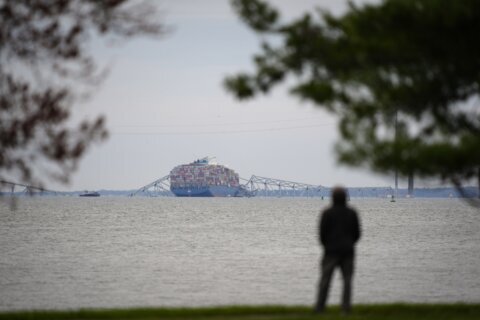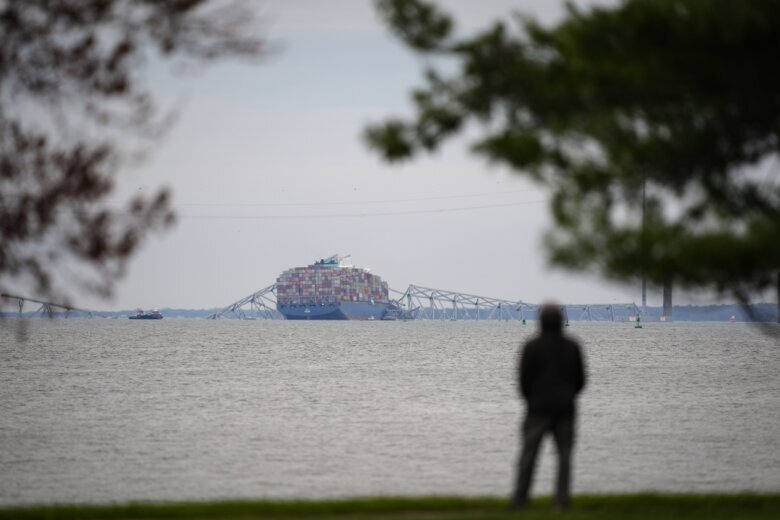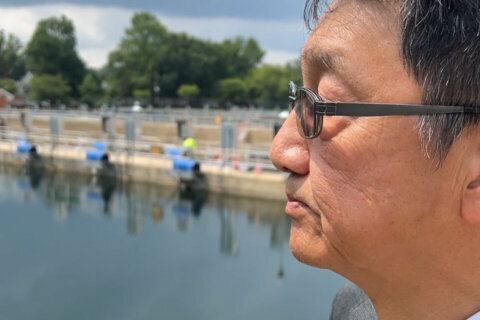
BALTIMORE (AP) — Generations of Maryland workers — longshoremen, seafarers, steelworkers and crabbers whose livelihoods depend on Baltimore’s port — watched in disbelief last week as an iconic symbol of their maritime culture crumbled into the Patapsco River.
The deadly collapse of the historic Francis Scott Key Bridge has shaken Baltimore to its core.
“What happened was kind of a travesty,” said Joe Wade, a retired port worker who remembers fishing near the bridge as a child. “I’m not a crier, but … I got emotional.”
Baltimore was a port long before it was incorporated as a city — and long before the United States declared its independence from Britain. Many of the city’s brick row houses were built to house fishermen, dockworkers and sailors. They earned a reputation for being pioneering and tough, unafraid of rough seas and long days.
It’s a cultural identity that persists among modern-day watermen like Ryan “Skeet” Williams, who makes a living harvesting crabs from the Chesapeake Bay.
“We’re rugged and salty,” he said. “You build your own life.”
Williams relied on the Key Bridge to connect his small maritime community outside Baltimore with Maryland’s Eastern Shore, the lifeblood of the state’s robust seafood industry. Many of his friends and relatives used the bridge for their daily commutes.
Scott Cowan, president of the International Longshoremen’s Association Local 333, said the union represents about 2,400 people whose jobs now hang in the balance. Shipping traffic through the Port of Baltimore can’t resume until the underwater wreckage has been cleared.
“They always say it’s the port that built the city,” said Cowan, who followed in his father’s footsteps when he became a longshoreman decades ago.
The disaster early Tuesday marks the latest blow to a city whose storied history often gets lost in conversations about its more recent struggles: poverty, violent crime and population loss.
Six members of a roadwork crew plunged to their deaths after a 985-foot (300-meter) cargo ship lost power and crashed into the bridge, eliminating a key piece of Baltimore’s skyline and halting maritime traffic to one of the east coast’s busiest ports.
In the aftermath, some experts questioned whether the span’s supporting columns should have been better protected against the gigantic container ships that would routinely pass by them. But Baltimore is an old city with aging infrastructure that often receives little attention from national politicians.
Officials have promised to rebuild the Key Bridge, but that could take years.
“This is no ordinary bridge. This is one of the cathedrals of American infrastructure,” U.S. Transportation Secretary Pete Buttigieg said during a news conference in Baltimore earlier this week. “So the path to normalcy will not be easy. It will not be quick. It will not be inexpensive.”
A storied history: Francis Scott Key, and generations of dockworkers
Baltimore became a global leader in shipbuilding early on in its history. It later became a major transportation hub with the addition of a railroad line connecting the east coast to the Midwest and beyond.
During the War of 1812, British forces attacked Baltimore in hopes of weakening its industrial and maritime prowess. But American troops successfully defended south Baltimore’s Fort McHenry, and the invasion inspired Francis Scott Key to write the national anthem after he witnessed an American flag flying defiantly overhead following a night of heavy bombing.
More than 150 years later, construction began on a bridge that would be named in his honor.
The Key Bridge opened in 1977, spanning 1.6 miles (2.6 kilometers) at the entrance of Baltimore’s harbor and allowing residents to traverse the waterway without driving through the city. It provided a direct connection between two working-class, water-oriented communities that formed during World War II — when nearby steel mills produced hundreds of massive warships to aid in the defense effort.
Baltimore’s history is rife with iconic characters, from debaucherous pirates and corrupt politicians to the treasured poet Edgar Allan Poe and jazz legend Billie Holiday. Through it all, the port was a relative constant.
It has allowed countless people to earn a decent living by showing up and putting in the hours, including immigrants and other disenfranchised groups. And it has remained an economic engine, adapting and evolving even as other local businesses have shuttered amid declines in industrial production.
It currently processes more cars and farm equipment than any other port in the country. Last year alone, it handled $80 billion of foreign cargo, Maryland Gov. Wes Moore said at a news conference earlier this week.
“The collapse of the Key Bridge is not just a Maryland crisis. The collapse of the Key Bridge is a global crisis,” he said. “The national economy and the world’s economy depends on the Port of Baltimore.”
The loss of life falls on one of Baltimore’s hardworking communities
The men who died in the collapse were filling potholes during an overnight shift. While police quickly stopped traffic after the ship sent a mayday signal, they didn’t have time to alert the construction crew — a group of Latino immigrants in active pursuit of the American dream.
Two survivors were rescued almost immediately and divers recovered two bodies the following day. The remaining four victims are still missing and presumed dead.
Advocates say their deaths take on larger significance in the context of the myriad challenges facing immigrants in the U.S. The men were performing a physically grueling job for relatively low wages. They were laboring during nighttime hours to avoid inconveniencing Maryland commuters.
It comes as little surprise that these already disenfranchised workers are the ones who ended up paying the ultimate price, said Krish O’Mara Vignarajah, president of the Baltimore-based immigration services nonprofit Global Refuge. Immigrants will almost inevitably be involved in rebuilding the bridge as well, she added.
The workers came to Maryland from Mexico, Guatemala, El Salvador and Honduras, seeking higher wages and better opportunities for themselves and their families.
By settling in the Baltimore area, they added to a long history of immigration that has played a key role in shaping the city’s culture and commerce. That history is inextricably linked to the port.
Between the Civil War and World War I, Baltimore became one of the country’s largest points of entry for European immigrants. In 1868, an immigration pier opened in south Baltimore not far from the historic battlefield that birthed The Star-Spangled Banner.
Many immigrants passed through the city on their way to the Midwest, but others stayed and put down roots. Those without specialized skills or advanced education worked on the docks and in the railroad yards, often alongside African Americans who came north to escape slavery. Their contributions are memorialized in the Baltimore Immigration Museum, which occupies a historic building constructed in 1904 to house European immigrants.
“Baltimore became a real melting pot of cultures,” said local historian Johns Hopkins, who directs the nonprofit Baltimore Heritage.
In more recent decades, Latino immigrants have settled in and around Baltimore, though other cities have received larger influxes, likely because they’re experiencing more job growth.
CASA, an immigrant advocacy group based in Maryland, has been in contact with two of the families whose loved ones are among those still missing. Both men — Maynor Suazo Sandoval and Miguel Luna — were husbands and fathers who left their home countries over 15 years ago.
“These construction workers are absolutely essential,” said Gustavo Torres, the organization’s executive director. “In a time when there is so much hatred against the immigrant community, we look to the quiet leadership of Maynor and Miguel and appreciate how they uphold our society so that Americans can live comfortably.”
A key thoroughfare
Many port workers and thousands of others used the Key Bridge on a daily basis.
Along with their neighbors, they awoke Tuesday morning to news of its demise and quickly logged onto social media, still in disbelief. They watched video footage showing every detail of the catastrophic collapse, replaying the horrific sequence until it finally seemed real.
Seeing a major piece of their city’s infrastructure crumble like a toy left some Baltimoreans with an uneasy sense of shock, jolted by the realization that anything can happen.
In the days that followed, many residents stopped at various vantage points near the collapse site to survey the wreckage and pay their respects. Some recalled watching the bridge take shape in the 1970s, arching majestically across the water.
“It was always there. It was a landmark,” said Niki Putinski, who spent years living in a small residential neighborhood at the base of the bridge. “I just didn’t think something could bring it down like that.”
The whole city is grieving, said Baltimore Mayor Brandon Scott, whose father moved to Baltimore as a young man to work at the port. But there’s a reason Baltimoreans are known for their grit and perseverance, Scott said.
“You can’t talk about Baltimore — past, present and future — without talking about the port,” he said. “And this will be the latest example of Baltimore bouncing back. That’s really ingrained in us here. We don’t give up, we ignore the noise and we keep that gritty chip on our shoulder.”
___
Associated Press video journalist Nathan Ellgren contributed to this report from Baltimore.
Copyright © 2024 The Associated Press. All rights reserved. This material may not be published, broadcast, written or redistributed.








